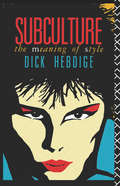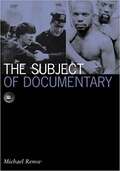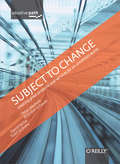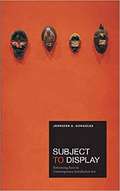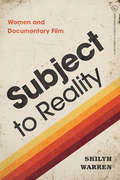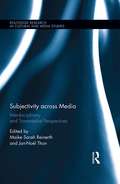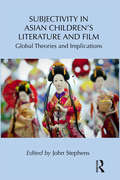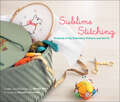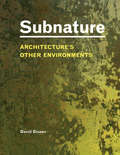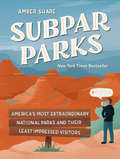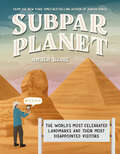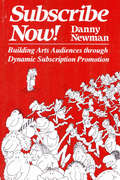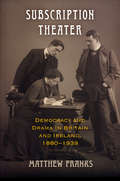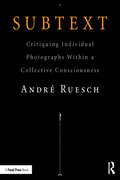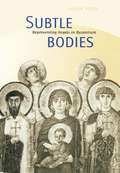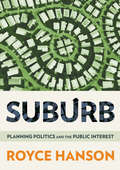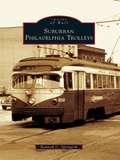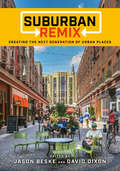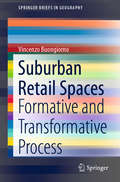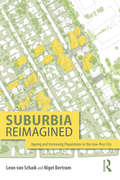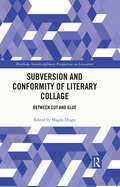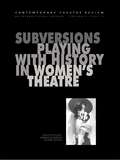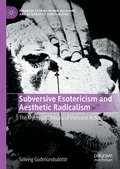- Table View
- List View
Subculture: The Meaning of Style (New Accents)
by Dick Hebdige'Hebdige's Subculture: The Meaning of Style is so important: complex and remarkably lucid, it's the first book dealing with punk to offer intellectual content. Hebdige [...] is concerned with the UK's postwar, music-centred, white working-class subcultures, from teddy boys to mods and rockers to skinheads and punks.' - Rolling Stone With enviable precision and wit Hebdige has addressed himself to a complex topic - the meanings behind the fashionable exteriors of working-class youth subcultures - approaching them with a sophisticated theoretical apparatus that combines semiotics, the sociology of devience and Marxism and come up with a very stimulating short book - Time Out This book is an attempt to subject the various youth-protest movements of Britain in the last 15 years to the sort of Marxist, structuralist, semiotic analytical techniques propagated by, above all, Roland Barthes. The book is recommended whole-heartedly to anyone who would like fresh ideas about some of the most stimulating music of the rock era - The New York Times
Subject Matter: The Anaesthetics of Habit and the Logic of Breakdown (Short Circuits)
by Aron VinegarA theorization of habit that emphasizes its excessive and unsettling qualities rather than its mediating, adaptive, and stabilizing functions.Subject Matter offers a bold counterpoint to prevalent conceptions of habit characterized by bodily fluidity and ease, as the stabilizing foundation of an emerging subjectivity, or, more negatively, as a numbing and deadening force. Instead of facilitating the coordination of action with goal and self with environment, habit appears here as a disruptively recursive operation with extreme ontological implications that are often more quotidian than exceptional. Vinegar theorizes habit&’s more perturbing aspects, from repetition compulsion to kenosis to breakdown, through an encounter between Hegel&’s philosophy (of habit), psychoanalytic dimensions of repetition, Tom McCarthy&’s novel Remainder, and Omer Fast&’s feature-length film interpretation of the novel.Vinegar starts with the premise that habit is an &“unhappy mediator,&” a disturbance of the very medium and milieu that is constitutive of the subject. Subject Matter pays close attention to those aspects of habit that are usually considered deviations from, or potential threats to, habit proper and that generate a logic of breakdown: automaticity, mechanization, thingness, inertia, and fixity. By plotting a topology of habit&’s unbearability through detailed accounts of its manifestation in writing, art, aesthetics, and visuality—and through an attentiveness to the unbalanced nonrelations between mediation and immediacy, being and having, fixity and fluidity, vanishing and overflowing, abbreviation and excess, beginning and ending—Vinegar exposes habit&’s failure to mediate and inhabit. In doing so, he offers new and counterintuitive insights into how habit generates the unruly grounds it is supposed to settle, thus allowing us to ask how we might break down differently.
Subject Of Documentary (Visible Evidence Ser. #Vol. 16)
by Michael RenovThe documentary, a genre as old as cinema itself, has traditionally aspired to objectivity. Whether making ethnographic, propagandistic, or educational films, documentarians have pointed the camera outward, drawing as little attention to themselves as possible. In recent decades, however, a new kind of documentary has emerged in which the filmmaker has become the subject of the work. Whether chronicling family history, sexual identity, or a personal or social world, this new generation of nonfiction filmmakers has defiantly embraced autobiography. In The Subject of Documentary, Michael Renov focuses on how documentary filmmaking has become an important means for both examining and constructing selfhood. By looking at key figures in documentary filmmaking as well as noncanonical video art and avant-garde artists, Renov broadens the definition of what counts as documentary, and explores the intersection of the personal and political, considering how memory can create a way into asking troubling questions about identity, oppression, and resiliency. Offering historical context for the explosion of personal nonfiction filmmaking in the 1980s and 1990s, Renov analyzes films in which the subjectivity of the filmmaker is expressly defined in relation to political struggle or historical trauma, from Haskell Wexler's Medium Cool to Jonas Mekas's Lost, Lost, Lost. And, looking beyond the traditional documentary, Renov contemplates such nontraditional modes of autobiographical practice as the essay film, the video confession, and the personal Web page.Unique in its attention to diverse expressions of personal nonfiction filmmaking, The Subject of Documentary forges a new understanding of the heightened role and function of subjectivity in contemporary documentary practice.Michael Renov is professor of critical studies at the USC School of Cinema-Television. He is the editor of Theorizing Documentary and the coeditor of Resolutions: Contemporary Video Practices (Minnesota, 1996) and Collecting Visible Evidence (Minnesota, 1999).
Subject To Change: Adaptive Path on Design (Adaptive Path)
by Peter Merholz Todd Wilkens Brandon Schauer David VerbaTo achieve success in today's ever-changing and unpredictable markets, competitive businesses need to rethink and reframe their strategies across the board. Instead of approaching new product development from the inside out, companies have to begin by looking at the process from the outside in, beginning with the customer experience. It's a new way of thinking-and working-that can transform companies struggling to adapt to today's environment into innovative, agile, and commercially successful organizations.Companies must develop a new set of organizational competencies: qualitative customer research to better understand customer behaviors and motivations; an open design process to reframe possibilities and translate new ideas into great customer experiences; and agile technological implementation to quickly prototype ideas, getting them from the whiteboard out into the world where people can respond to them.In Subject to Change: Creating Great Products and Services for an Uncertain World, Adaptive Path, a leading experience strategy and design company, demonstrates how successful businesses can-and should-use customer experiences to inform and shape the product development process, from start to finish.
Subject To Display: Reframing Race In Contemporary Installation Art
by Jennifer A. GonzalezOver the past two decades, artists James Luna, Fred Wilson, Amalia Mesa-Bains, Pepón Osorio, and Renée Green have had a profound impact on the meaning and practice of installation art in the United States. In Subject to Display, Jennifer González offers the first sustained analysis of their contribution, linking the history and legacy of race discourse to innovations in contemporary art. Race, writes González, is a social discourse that has a visual history. The collection and display of bodies, images, and artifacts in museums and elsewhere is a primary means by which a nation tells the story of its past and locates the cultures of its citizens in the present. All five of the American installation artists González considers have explored the practice of putting human subjects and their cultures on display by staging elaborate dioramas or site-specific interventions in galleries and museums; in doing so, they have created powerful social commentary of the politics of space and the power of display in settings that mimic the very spaces they critique. These artists' installations have not only contributed to the transformation of contemporary art and museum culture, but also linked Latino, African American, and Native American subjects to the broader spectrum of historical colonialism, race dominance, and visual culture. From Luna's museum installation of his own body and belongings as “artifacts” and Wilson's provocative juxtapositions of museum objects to Mesa-Bains's allegorical home altars, Osorio's condensed spaces (bedrooms, living rooms; barbershops, prison cells) and Green's genealogies of cultural contact, the theoretical and critical endeavors of these artists demonstrate how race discourse is grounded in a visual technology of display.
Subject to Reality: Women and Documentary Film (Women & Film History International)
by Shilyh WarrenRevolutionary thinking around gender and race merged with new film technologies to usher in a wave of women's documentaries in the 1970s. Driven by the various promises of second-wave feminism, activist filmmakers believed authentic stories about women would bring more people into an imminent revolution. Yet their films soon faded into obscurity. Shilyh Warren reopens this understudied period and links it to a neglected era of women's filmmaking that took place from 1920 to 1940, another key period of thinking around documentary, race, and gender. Drawing women’s cultural expression during these two explosive times into conversation, Warren reconsiders key debates about subjectivity, feminism, realism, and documentary and their lasting epistemological and material consequences for film and feminist studies. She also excavates the lost ethnographic history of women's documentary filmmaking in the earlier era and explores the political and aesthetic legacy of these films in more explicitly feminist periods like the Seventies. Filled with challenging insights and new close readings, Subject to Reality sheds light on a profound and unexamined history of feminist documentaries while revealing their influence on the filmmakers of today.
Subjectivity across Media: Interdisciplinary and Transmedial Perspectives (Routledge Research in Cultural and Media Studies)
by Jan-Noël Thon Maike Sarah ReinerthMedia in general and narrative media in particular have the potential to represent not only a variety of both possible and actual worlds but also the perception and consciousness of characters in these worlds. Hence, media can be understood as "qualia machines," as technologies that allow for the production of subjective experiences within the affordances and limitations posed by the conventions of their specific mediality. This edited collection examines the transmedial as well as the medium-specific strategies employed by the verbal representations characteristic for literary texts, the verbal-pictorial representations characteristic for comics, the audiovisual representations characteristic for films, and the interactive representations characteristic for video games. Combining theoretical perspectives from analytic philosophy, cognitive theory, and narratology with approaches from phenomenology, psychosemiotics, and social semiotics, the contributions collected in this volume provide a state-of-the-art map of current research on a wide variety of ways in which subjectivity can be represented across conventionally distinct media.
Subjectivity in Asian Children's Literature and Film: Global Theories and Implications (Children's Literature and Culture)
by John StephensWinner of the Children’s Literature Association Honor Book Award This volume establishes a dialogue between East and West in children’s literature scholarship. In all cultures, children’s literature shows a concern to depict identity and individual development, so that character and theme pivot on questions of agency and the circumstances that frame an individual’s decisions and capacities to make choices and act upon them. Such issues of selfhood fall under the heading subjectivity. Attention to the representation of subjectivity in literature enables us to consider how values are formed and changed, how emotions are cultivated, and how maturation is experienced. Because subjectivities emerge in social contexts, they vary from place to place. This book brings together essays by scholars from several Asian countries — Japan, India, Pakistan, Korea, Vietnam, Taiwan, Australia, Thailand, and The Philippines — to address subjectivities in fiction and film within frameworks that include social change, multiculturalism, post-colonialism, globalization, and glocalization. Few scholars of western children's literature have a ready understanding of what subjectivity entails in children’s literature and film from Asian countries, especially where Buddhist or Confucian thought remains influential. This volume will impact scholarship and pedagogy both within the countries represented and in countries with established traditions in teaching and research, offering a major contribution to the flow of ideas between different academic and educational cultures.
Sublime Stitching: Hundreds of Hip Embroidery Patterns and How-To
by Alexandra Grablewski Jenny HartElizabeth Taylor, Carrie Fisher, Tracey Ullman, and Laura Dern all own her work. Now, in her much-anticipated first book, embroidery pioneer Jenny Hart brings her sublime designs to everyone. Expanding on the offerings of her Stitch-It Kit, Sublime Stitching offers all the instructions, tips, and hip patterns needed to create hundreds of stylish projects. Perfect for stitchers of all experience levels, this charmingly photographed book includes simple directions and inspiring project ideas for stitching up jeans, handbags, neckties, baby bibs, and more. Best of all are the entirely original, ready-to-use iron-on patterns bound in the back. Jenny has included all sorts of delightful designsfrom cheeky margaritas and maracas to classic teapots and cupcakes. These patterns are easy to remove after using, and a cinch to store in the handy pockets on the inside covers. Believe it or not, each pattern can be used up to nine times. Now that's sublime.
Subnature: Architecture's Other Environments
by David GissenWe are conditioned over time to regard environmental forces such as dust, mud, gas, smoke, debris, weeds, and insects as inimical to architecture. Much of today's discussion about sustainable and green design revolves around efforts to clean or filter out these primitive elements. While mostly the direct result of human habitation, these 'subnatural forces' are nothing new. In fact, our ability to manage these forces has long defined the limits of civilized life. From its origins, architecture has been engaged in both fighting and embracing these so-called destructive forces. In Subnature, David Gissen, author of our critically acclaimed Big and Green, examines experimental work by today's leading designers, scholars, philosophers, and biologists that rejects the idea that humans can somehow recreate a purely natural world, free of the untidy elements that actually constitute nature. Each chapter provides an examination of a particular form of subnature and its actualization in contemporary design practice.The exhilarating and at times unsettling work featured in Subnature suggests an alternative view of natural processes and ecosystems and their relationships to human society and architecture. R&Sie(n)'s Mosquito Bottleneck house in Trinidad uses a skin that actually attracts mosquitoes and moves them through the building, while keeping them separate from the occupants. In his building designs the architect Philippe Rahm draws the dank air from the earth and the gasses and moisture from our breath to define new forms of spatial experience. In his Underground House, Mollier House, and Omnisport Hall, Rahm forces us to consider the odor of soil and the emissions from our body as the natural context of a future architecture. [Cero 9]'s design for the Magic Mountain captures excess heat emitted from a power generator in Ames, Iowa, to fuel a rose garden that embellishes the industrial site and creates a natural mountain rising above the city's skyline. Subnature looks beyond LEED ratings, green roofs, and solar panels toward a progressive architecture based on a radical new conception of nature.
Subpar Parks: America's Most Extraordinary National Parks and Their Least Impressed Visitors
by Amber Share**A New York Times Bestseller!** Based on the wildly popular Instagram account, Subpar Parks features both the greatest hits and brand-new content, all celebrating the incredible beauty and variety of America&’s national parks juxtaposed with the clueless and hilarious one-star reviews posted by visitors. Subpar Parks, both on the popular Instagram page and in this humorous, informative, and collectible book, combines two things that seem like they might not work together yet somehow harmonize perfectly: beautiful illustrations and informative, amusing text celebrating each national park paired with the one-star reviews disappointed tourists have left online. Millions of visitors each year enjoy Glacier National Park, but for one visitor, it was simply "Too cold for me!" Another saw the mind-boggling vistas of Bryce Canyon as "Too spiky!" Never mind the person who visited the thermal pools at Yellowstone National Park and left thinking, &“Save yourself some money, boil some water at home.&” Featuring more than 50 percent new material, the book will include more depth and insight into the most popular parks, such as Yosemite, Yellowstone, the Grand Canyon, and Acadia National Parks; anecdotes and tips from rangers; and much more about author Amber Share's personal love and connection to the outdoors. Equal parts humor and love for the national parks and the great outdoors, it's the perfect gift for anyone who loves to spend time outside as well as have a good read (and laugh) once they come indoors.
Subpar Planet: The World's Most Celebrated Landmarks and Their Most Disappointed Visitors
by Amber ShareNew York Times bestselling author and illustrator of Subpar Parks Amber Share takes us around the globe to celebrate the world&’s greatest wonders alongside hysterical reviews from their harshest critics.The world is filled with marvels—both natural and human-made— and artist Amber Share has made it her mission to capture the unique majesty of these sites alongside reactions from some of their most vocal visitors. The Dead Sea? &“Who needs burning eyes?&” Who indeed? Big Ben? &“Just a really big clock.&” Go figure. With Share's classic spin on visitors&’ candidly cranky reviews of each location, Subpar Planet fills skeptical travelers with a wanderlust for the world's most spectacular features, including the Eiffel Tower, the Taj Mahal, the Great Barrier Reef, Chichén Itzá, the Sahara, and many more! Equal parts hilarious and informative, Subpar Planet is perfect for seasoned globe-trotters, people interested in broadening their worldly horizons, and anyone who simply wants to see the unique ways their fellow human beings interact with the world around them.
Subscribe Now!
by Danny Newman"Buy it, borrow it, steal it, but get your hands on it! If you follow Danny's advice on how to sell tickets, you won't have an unsold seat in the house all season long!"--Ralph Black, American Symphony League
Subscription Theater: Democracy and Drama in Britain and Ireland, 1880-1939 (Material Texts)
by Matthew FranksSubscription Theater asks why turn-of-the-century British and Irish citizens spent so much time, money, and effort adding their names to subscription lists. Shining a spotlight on private play-producing clubs, public repertory theaters, amateur drama groups, and theatrical magazines, Matthew Franks locates subscription theaters in a vast constellation of civic subscription initiatives, ranging from voluntary schools and workers' hospitals to soldiers' memorials and Diamond Jubilee funds. Across these enterprises, Franks argues, subscribers created their own spaces for performing social roles from which they had long been excluded. Whether by undermining the authority of the Lord Chamberlain's Examiner of Plays and London's commercial theater producers, or by extending rights to disenfranchised women and property-less men, a diverse cast of subscribers including typists, plumbers, and maids acted as political representatives for their fellow citizens, both inside the theater and far beyond it. Citizens prized a "democratic" or "representative" subscription list as an end in itself, and such lists set the stage for the eventual public subsidy of subscription endeavors.Subscription Theater points to the importance of printed ephemera such as programs, tickets, and prospectuses in questioning any assumption that theatrical collectivity is confined to the live performance event. Drawing on new media as well as old, Franks uses a database of over 23,000 stage productions to reveal that subscribers introduced nearly a third of the plays that were most frequently revived between 1890 and the mid-twentieth century, as well as nearly half of all new translations, and they were instrumental in staging the work of such writers as Shaw and Ibsen, whose plays featured subscription lists as a plot point or prop. Although subscribers often are blamed for being a conservative force in theater, Franks demonstrates that they have been responsible for how we value audience and repertoire today, and their history offers a new account of the relationship between ephemera, drama, and democracy.
Subtext: Critiquing Individual Photographs within a Collective Consciousness
by Andre RueschSubtext invites and encourages personal and blatantly subjective responses to photographs and analyzes the drivers behind them. During decades of participating in critiques as both student and teacher, André Ruesch has become convinced that it is the personal response to work that connects us in the most visceral and meaningful way. This book aims to encourage and educate viewers how to read and understand photographs on a deeper level, honoring and validating their responses to photographs. This book seeks to vitalize students in the photography classroom. Rather than a dense tome of theory, this is an accessible guide to taking individual ownership of—and enjoying—the visual experience. To be visually literate is comparable to being linguistically literate. Such literacy is necessary to engender a deeper understanding and valuation of culture: both types of literacy create, enrich, define and historically document the expression of one individual to be shared by all.
Subtle Bodies: Representing Angels in Byzantium
by Glenn PeersHow Byzantine artists approached the problem of representing the incorporeal, immaterial forms and inscrutable natures of angels.
Suburb: Planning Politics and the Public Interest
by Royce HansonLand-use policy is at the center of suburban political economies because everything has to happen somewhere but nothing happens by itself. In Suburb, Royce Hanson explores how well a century of strategic land-use decisions served the public interest in Montgomery County, Maryland, a suburb of Washington, D.C. Transformed from a rural hinterland into the home a million people and a half-million jobs, Montgomery County built a national reputation for innovation in land use policy—including inclusive zoning, linking zoning to master plans, preservation of farmland and open space, growth management, and transit-oriented development.A pervasive theme of Suburb involves the struggle for influence over land use policy between two virtual suburban republics. Developers, their business allies, and sympathetic officials sought a virtuous cycle of market-guided growth in which land was a commodity and residents were customers who voted with their feet. Homeowners, environmentalists, and their allies saw themselves as citizens and stakeholders with moral claims on the way development occurred and made their wishes known at the ballot box. In a book that will be of particular interest to planning practitioners, attorneys, builders, and civic activists, Hanson evaluates how well the development pattern produced by decades of planning decisions served the public interest.
Suburban Form: An International Perspective
by Kiril Stanilov Brenda Case ScheerThis book examines and documents the remarkable development and transformation of suburban form throughout the globe during the twentieth century. The premise that suburban areas are monotonous, inert environments is put to a test through investigation of the complexity of those suburban settings and the dynamic physical changes that have taken place since their inception.
Suburban Philadelphia Trolleys
by Kenneth C. SpringirthThe Philadelphia Suburban Transportation Company prospered through the hard times of the 1930s and was the last privately-owned trolley system in the United States. Aerodynamically designed Bullet cars of the Philadelphia and Western Railway dramatically reduced travel time on the Sixty-ninth Street toNorristown line. The Presidents' Conference Committee trolley cars of the Philadelphia Transportation Company linked the boroughs of Darby, Colwyn, and Yeadon with Philadelphia. Photographs of Media's 1977 town fair feature vintage trolleys in the only suburban community in the United States with a trolley line ending in its main street. Suburban Philadelphia Trolleys covers the history of the trolleys that served Philadelphia's western suburbs.
Suburban Remix: Creating the Next Generation of Urban Places
by David Dixon Jason BeskeThe suburban dream of a single-family house with a white picket fence no longer describes how most North Americans want to live. The dynamics that powered sprawl have all but disappeared. Instead, new forces are transforming real estate markets, reinforced by new ideas of what constitutes healthy and environmentally responsible living. Investment has flooded back to cities because dense, walkable, mixed-use urban environments offer choices that support diverse dreams. Auto-oriented, single-use suburbs have a hard time competing.Suburban Remix brings together experts in planning, urban design, real estate development, and urban policy to demonstrate how suburbs can use growing demand for urban living to renew their appeal as places to live, work, play, and invest. The case studies and analyses show how compact new urban places are already being created in suburbs to produce health, economic, and environmental benefits, and contribute to solving a growing equity crisis.Above all, Suburban Remix shows that suburbs can evolve and thrive by investing in the methods and approaches used successfully in cities. Whether next-generation suburbs grow from historic village centers (Dublin, Ohio) or emerge de novo in communities with no historic center (Tysons, Virginia), the stage is set for a new chapter of development—suburbs whose proudest feature is not a new mall but a more human-scale feel and form.
Suburban Retail Spaces: Formative and Transformative Process (SpringerBriefs in Geography)
by Vincenzo BuongiornoThis book derives from observations of the contemporary built environment and its contradictions. The suburban retail spaces, specifically the suburban shopping mall, and the changes caused by them within urban organisms are the object of the investigation synthesized in the volume. The topic is very crucial for the development of the contemporary city. It constitutes at the same time a problem (large commercial structures' spread is 'destroying' traditional commercial urban fabrics) and an opportunity (shopping malls are the most vital parts of the new suburbs and can play the role of community nucleus in urban and suburban areas). Furthermore, the spread of e-commerce forces these structures to functional and spatial transformations that brings also a new relationship with the city.The analytical reading, supplemented by generative and design projections, is carried out by using the conceptual and methodological tools of urban morphology, specifically those of the typological processual approach. From this specific point of view, the suburban shopping mall is read as an organism (a complex system characterized by mutual solidarity and interdependence among component elements) in itself, and as a sub-organisms belonging to the largest territorial organism.The book is intended to offer, to operators, scholars, researchers, professionals and students, a reading and design method, to interpret an important aspect of the contemporary built environment by analyzing the suburban commercial space case. It offers at the same time a model applicable to other specific not-commercial cases, to defining paths for further research and design developments.
Suburbia Reimagined: Ageing and Increasing Populations in the Low-Rise City
by Nigel Bertram Leon van SchaikWorldwide, more and more people are living in cities, with suburbs conceived as appendages to the city, rather than being part of the city system, which is densely populated and offers a full range of services. But suburbs are not the city spread too thin, and in fact hold potential for a lived complexity as satisfying as that assumed to be available in inner cities. Just as the ecological function of wetlands was ignored by modernist planning, and swamps once-drained are now recognised as vital to water cycles, suburbs are increasingly recognised as part of a city’s wellbeing with their own alternative ideology and opportunities for urbanity and ecological sustainability. Suburbia Reimagined shows how such subdivision structures can offer new possibilities for sustainably integrating living between generations and between established and arriving migrant communities. The authors worked locally and internationally with university campuses, shopping centres, hospitals, airports, and other large entities spread through suburbia, to identify a broad range of suburban situations that have been modified to ensure that residents have a full access to amenities and services. The book addresses the history and design of suburbia, from the post-war soldier settlements of the 40s and 50s to the university hinterlands of Silicon Valley in order to reappraise the locked potential within such subdivision patterns. The authors propose a new model forward, examining case studies ranging from repurposed malls and railways for ecological sustainability to cul-de-sacs as social units and post-industrial factory conversions, ultimately showing the nascent patterns in suburbia that have the potential to support a rich life for all age groups.
Subversion and Conformity of Literary Collage: Between Cut and Glue (Routledge Interdisciplinary Perspectives on Literature)
by Magda DraguSubversion and Conformity of Literary Collage: Between Cut and Glue fills a gap in the current scholarship on literary collage, by addressing how different the interpretations of the concept are, depending on the author who uses the concept and the material and writers surveyed. The book studies writers who employed literary collage during the twentieth and twenty-first centuries, some whose works have been intensely analyzed from this perspective (William S. Burroughs and Walter Benjamin), but also some whose collage-writing style has recently been investigated by writers, being usually placed under the umbrella term of artist books (Stelio Maria Martini).
Subversions
by Julie Wilkinson Gabriele Griffin Erika BlockFirst Published in 1998. Routledge is an imprint of Taylor & Francis, an informa company.
Subversive Esotericism and Aesthetic Radicalism: The Myths and Rituals of Viennese Actionism (Palgrave Studies in New Religions and Alternative Spiritualities)
by Sólveig GuðmundsdóttirIn this book, Sólveig Guðmundsdóttir uncovers the crucial role of esotericism in the art of the Vienna Actionists—a group of Austrian neo-avant-garde artists, infamous for their transgressive performance art. Addressing this frequently overlooked aspect of Actionism, Guðmundsdóttir traces, historicizes, and examines the esoteric discourses in selected works: the collective manifesto Die Blutorgel (1962), Rudolf Schwarzkogler’s text Das Ästhetische Panorama (1967/68) and the performances Abreaktionsspiel (1970) by Hermann Nitsch, and Zerreißprobe (1970) by Günter Brus. Mapping out the various discursive entanglements as they appear in the works, i.e. between esotericism and psychoanalysis, fascism, gender, sexuality, aesthetics, science, orientalism and religious discourses, the author illustrates and establishes the importance of esoteric traditions for the Actionists’ art and subversive practices. The historical analysis of the artworks reflects on the cultural nexus of post-war Austria, as well as the relations between radical politics, countercultures and esotericism, and how they appear in Actionism. Guðmundsdóttir argues that to survey the historical placement of esotericism is vital for understanding not only the context of their works, but also the contradictory image of the Actionists as both anti-authoritarian and reactionary artists.
